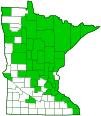European bur-reed
(Sparganium emersum)
Conservation • Wetland • Description • Habitat • Ecology • Use • Distribution • Taxonomy
Description |
||
European bur-reed is an 8″ to 24″ tall, erect, perennial, emergent or floating, aquatic forb that rises on basal leaves and a single stem from fibrous roots and an underground horizontal stem (rhizome). Basal leaves are strap-shaped (linear). Some may stand above the water (emergent), while others float on the surface. They surround (sheath) the stem at the base and taper to a point at the tip. Emergent leaves are stiff, spongy, 12″ to 32″ long, and ⅛″ to ⅜″ wide. They are parallel-veined and flat (not rounded on the back), and partially to entirely folded with a raised ridge (keeled). The upper and lower surfaces are hairless. The margins are untoothed. Floating leaves are similar but limp, up to 80″ long, ⅛″ to 11 ⁄16″wide, and keeled, at least near the base. Stem leaves are reduced to persistent, leaf-like bracts. The bracts are alternate, ascending or spreading, broadened and thickened at the base, and otherwise similar to the basal leaves. They become much smaller as they ascend the stem. The stem is hairless, unbranched, and usually erect, sometimes floating. Stem leaves are Male and female inflorescences are produced on the same plant. Flowers are grouped in dense, spherical, unisexual heads with numerous flowers on an erect, unbranched, somewhat zigzagged, 4″ to 8″ long stalk at the end of the stem. There are usually 3 to 7, sometimes up to 10, male (staminate) heads at the top and 1 to 6 female (pistillate) heads below. The lowermost pistillate heads are on stalks that connect to the stem above, not in, the uppermost bract axils. The upper pistillate heads and the staminate heads are stalkless. Pistillate heads are ⅝″ to 1⅜″ in diameter when in fruit. Individual flowers are tiny. Staminate flowers have 1 to 6 tepals and 2 to 8 stamens. The tepals are free, not united at the base. They are scale-like, club-shaped to spatula-shaped, and green at first, soon turning white or whitish. They do not have a dark thickened area just below the tip. The margin at the tip is irregularly toothed, appearing gnawed. The stamens have filaments that are much longer than the tepals. The anthers are attached by the base to the filaments. Pistillate flowers have 1 style with 1 stigma. The style is much longer than the tepals. The stigma is white to greenish. The flowers are pollinated by wind. The fruit is similar to and often called an achene but is actually a drupe, with a fleshy exterior surrounding a single stone-like seed. It is shiny, 3 ⁄16″long, 1 ⁄16″ wide, and spindle-shaped, widest at the middle and tapered at both ends. It is green at first, turning reddish-brown at maturity. The dried style persists as a beak attached to the tip. The beak is shorter than the body. |
||
Height |
||
8″ to 24″ |
||
Flower Color |
||
White or whitish |
||
Similar Species |
||
American bur-reed (Sparganium americanum) inflorescence is sometimes branched. The pistillate heads are stalkless in the bract axils. The fruits are not shiny. Common bur-reed (Sparganium eurycarpum) is a larger plant, up to 40″ tall. All or most of the pistillate flowers have two stigmas. The fruit is broadly pyramid-shaped. Narrow-leaved cattail (Typha angustifolia) leaves are conspicuously rounded on the back. |
||
Habitat |
||
Shallow water. Margins of lakes and swamps, in ponds and streams, and in backwaters of large rivers. Full sun. Muddy soil. |
||
Ecology |
||
Flowering |
||
June to August |
||
Pests and Diseases |
||
|
||
Use |
||
|
||
Distribution |
||||
|
Sources |
|||
| 4/14/2023 | ||||
Nativity |
||||
Native |
||||
Occurrence |
||||
Common |
||||
Taxonomy |
|||
| Kingdom | Plantae (Plants) | ||
| Division | Tracheophyta (Vascular Plants) | ||
| Subdivision | Spermatophytina (Seed Plants) | ||
| Class | Liliopsida (Monocots) | ||
Order |
Poales (grasses, sedges, cattails, and allies) | ||
Family |
Typhaceae (bulrushes, cattails, and allies) | ||
| Tribe | Sparganieae | ||
Genus |
Sparganium (bur-reeds) | ||
The genus Sparganium was formerly placed by itself in the family Sparganiaceae. Phylogenetic analysis showed it to be closely related to cattails in the genus Typha. It was moved to the cattail (Typhaceae) family in 2009. |
|||
Synonyms |
|||
Sparganium acaule Sparganium chlorocarpum Sparganium chlorocarpum var. acaule Sparganium simplex |
|||
Common Names |
|||
European bur-reed greenfruit bur-reed narrowleaf bur-reed narrow-leaved burreed unbranched bur-reed |
|||
Glossary
Achene
A dry, one-chambered, single-seeded seed capsule, formed from a single carpel, with the seed attached to the membranous outer layer (wall) only by the seed stalk; the wall, formed entirely from the wall of the superior ovary, does not split open at maturity, but relies on decay or predation to release the contents.
Axil
The upper angle where a branch, stem, leaf stalk, or vein diverges.
Bract
Modified leaf at the base of a flower stalk, flower cluster, or inflorescence.
Drupe
A fleshy fruit with usually a single hard, stone-like core, like a cherry or peach; a stone fruit.
Emergent
Growing out of the water and held above the water surface.
Filament
On plants: The thread-like stalk of a stamen which supports the anther. On Lepidoptera: One of a pair of long, thin, fleshy extensions extending from the thorax, and sometimes also from the abdomen, of a caterpillar.
Keeled
Folded, as in a grass blade, or with a raised ridge, as in a grass sheath; like the keel of a boat.
Linear
Long, straight, and narrow, with more or less parallel sides, like a blade of grass.
Pistillate
Referring to a flower that has a female reproductive organ (pistil) but does not have male reproductive organs (stamens).
Rhizome
A horizontal, usually underground stem. It serves as a reproductive structure, producing roots below and shoots above at the nodes.
Scale
In plants, a small, usually flat and thin, modified leaf resembling the scale of a fish.
Sheath
The lower part of the leaf that surrounds the stem.
Staminate
Referring to a flower that has a male reproductive organs (stamens) but does not have a female reproductive organ (pistil).
Stigma
In plants, the portion of the female part of the flower that is receptive to pollen. In Lepidoptera, an area of specialized scent scales on the forewing of some skippers, hairstreaks, and moths. In Odonata, a thickened, dark or opaque cell near the tip of the wing on the leading edge.
Tepal
Refers to both the petals and the sepals of a flower when they are similar in appearance and difficult to tell apart. Tepals are common in lilies and tulips.
Visitor Photos |
|||||
Share your photo of this plant. |
|||||
| This button not working for you? Simply email us at info@MinnesotaSeasons.com. Attach one or more photos and, if you like, a caption. |
|||||
|
|||||
MinnesotaSeasons.com Photos |
|||||
Plant |
|||||
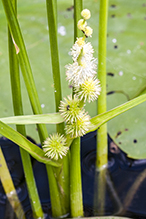 |
|||||
Male Inflorescence |
|||||
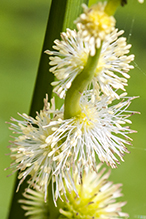 |
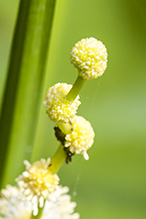 |
||||
Female Inflorescence |
|||||
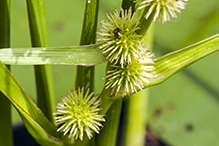 |
|||||

Slideshows |
||

Visitor Videos |
|||
Share your video of this plant. |
|||
| This button not working for you? Simply email us at info@MinnesotaSeasons.com. Attach a video, a YouTube link, or a cloud storage link. |
|||
Other Videos |
|||
| European Bur-Reed (Sparganium Emersum) - 2012-07-01 Westdelta |
|||
About
Published on Jul 2, 2012 Sparganium emersum is a species of flowering plant in the cat-tail family known by the common name European bur-reed. ------------------- 52.02455 4.30568 |
|||

Visitor Sightings |
|||||
Report a sighting of this plant. |
|||||
| This button not working for you? Simply email us at info@MinnesotaSeasons.com. Be sure to include a location. |
|||||
|
|||||
MinnesotaSeasons.com Sightings |
|||||

|
Created: Last Updated: © MinnesotaSeasons.com. All rights reserved. |
